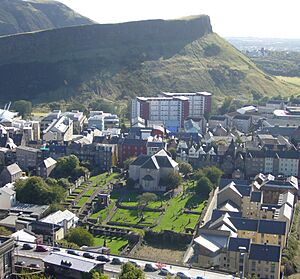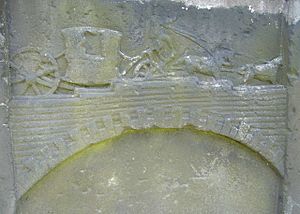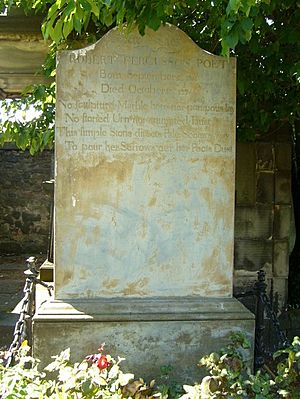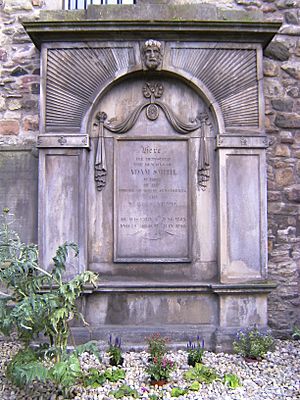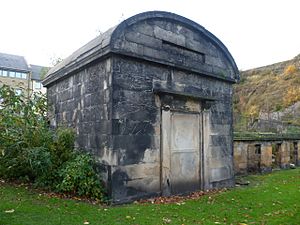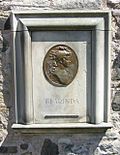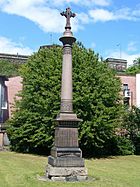Canongate Kirkyard facts for kids
The Canongate Kirkyard is a historic churchyard (or cemetery) located around the Canongate Kirk on Edinburgh's famous Royal Mile in Scotland. People have been buried here since the late 1680s, right up until the mid-20th century.
Many important people rest here, including the famous economist Adam Smith and the talented poet Robert Fergusson. Some people even claim that David Rizzio, who was the private secretary to Mary, Queen of Scots and was murdered, is buried here. However, it's very unlikely, as he was a Catholic and died long before this Protestant churchyard was established.
Contents
History of the Kirkyard
For a long time, the area called Canongate was a separate town from Edinburgh. Its church services were held at Holyrood Abbey and later at Lady Yester's Church. But in 1687, King James VII decided to use Holyrood Abbey as a special Royal Chapel. This meant the local people needed a new church.
So, the new Canongate Kirk was started in 1688 and finished in 1691. A large piece of land was bought for the church and also for a burial ground, which started being used right away in 1688. This area is now completely filled with graves.
Because of old rules, the Canongate parish also included Edinburgh Castle. This meant many soldiers from the castle were buried in the northern part of the churchyard.
In 1952, an old church hall was taken down. This space was turned into a lovely sunken garden. The ancient Burgh Cross, which dates back to 1128, was moved there. It used to stand in the road in front of the church.
Today, the Canongate Kirkyard has 62 tombs, 140 monuments, and 150 wall plaques or grave markers.
Famous People Buried Here
From the 1700s
- The Coachman's Stone (around 1770) is a unique grave marker. It shows a skull and the Latin phrase "memento mori" (meaning "remember you must die"). It was put up by a society of coach drivers. Below the words, there's a carving of a coach and horses crossing a bridge. These drivers worked the route from Edinburgh to London.
- John Frederick Lampe (1703–1751) was a composer who wrote hymn-tunes. His gravestone is now hard to read, but it once said his music would "out live Monumental register."
- George Drummond (1688–1766) was a very important leader in Edinburgh, serving as Lord Provost of Edinburgh six times. He helped create the Edinburgh New Town, built the Edinburgh Royal Infirmary, and drained the Nor’ Loch. He truly shaped modern Edinburgh.
- John Gregory (1724–1773) and his son James Gregory (1753–1821) were famous doctors. James even invented "Gregory's Powder," a medicine for stomach problems used for about 150 years!
- Poet Robert Fergusson (1750–1774) is one of the most celebrated burials. He started writing poetry at 22 but sadly died young. The famous poet Robert Burns was greatly inspired by Fergusson's work. Burns even paid for Fergusson's gravestone to be put up in 1828, long after Fergusson's death. The stone reads:
"Here lies Robert Fergusson, Poet Born September 5th 1751 Died October 16th 1774 No sculptured marble here, nor pompous lay No storied urn, nor animated bust This simple stone directs pale Scotia's way To pour her sorrows o’er her poet's dust"
A statue of Fergusson was placed near the churchyard entrance in 2004.
- Adam Smith (1723–1790) was a brilliant economist and writer of the book The Wealth of Nations. He is known as the founder of political economics. His grave is a popular spot for economists from all over the world to visit. He lived very close to the kirkyard.
From the 1800s
- Benjamin Bell (1749–1806) and his son Joseph Bell (1787–1848) were both surgeons. Benjamin Bell was the great-grandfather of another Joseph Bell, who was a teacher to the writer Arthur Conan Doyle. This later Joseph Bell was the inspiration for the famous detective character Sherlock Holmes!
- Mary Brunton (1778–1818) was an author, buried with her husband, Professor Alexander Brunton.
- John Ballantyne (1774–1821) and his brother James Ballantyne (1772–1833) were publishers and close friends of the famous writer Sir Walter Scott. James printed Scott's popular Waverley novels. Although they faced financial difficulties later in life, Scott deeply valued their friendship.
- Dugald Stewart (1753–1828) was a Professor of Moral Philosophy at Edinburgh University. His unique, sealed tomb is the only one of its kind in the churchyard. A large monument to him stands on nearby Calton Hill.
- Hugh William Williams (1773–1829) was a watercolor artist. He was known as "Grecian Williams" because of his travels. He is believed to have called Edinburgh "the modern Athens," which is fitting since his resting place is near Edinburgh's "Acropolis" (Calton Hill).
- Sir William Fettes (1750–1836) was a former merchant and also served as Lord Provost of Edinburgh. His generous gifts helped build Fettes College, a well-known school that opened in 1870. His large mausoleum explains how he wanted to provide a good education for less fortunate children.
- Mrs Agnes Maclehose (1759–1841) was a friend of Robert Burns. They wrote many letters to each other, and Burns called her "Clarinda." He even wrote famous poems to her, including "Ae Fond Kiss."
- Sir John Watson Gordon (1788–1864) was a talented portrait artist. He painted many important people, including Sir Walter Scott.
- Horatius Bonar (1808–1889) was a preacher and wrote many hymns.
Edinburgh Castle Soldiers' Memorial
A tall red granite cross stands in the churchyard, remembering the soldiers who died at Edinburgh Castle. It was put up in 1880. The cross marks a wide green area where many soldiers were buried with military honors between 1692 and 1880.
From the 1900s
- Architect Robert Hurd (1905–1963) was involved in rebuilding parts of the Canongate area in the 1950s. He was one of the last people to be buried here after the churchyard was officially closed for new burials.
Stories of Burials
- David Rizzio (1533–1566) was an Italian courtier to Mary, Queen of Scots. He was murdered in Holyrood Palace. While he was first buried at Holyrood Abbey, a small plaque on the church wall claims his body was moved to Canongate Kirkyard in 1688. However, this is very unlikely. Rizzio was Catholic, and it's not probable he would have been reburied in a Protestant churchyard so long after his death. It's probably just a fun story connected to an old, unreadable gravestone.
- Ebenezer Lennox Scroggie is a name some people say inspired Charles Dickens' famous character Ebenezer Scrooge in A Christmas Carol. It was thought that Scroggie was buried here. However, this theory is now known to be a "probable Dickens hoax," and there's no real proof that anyone named Scroggie was ever buried in the kirkyard.


